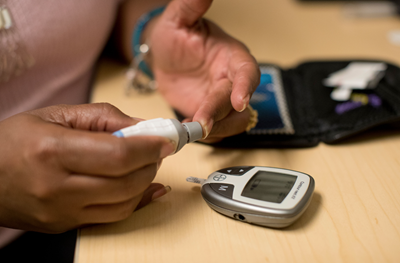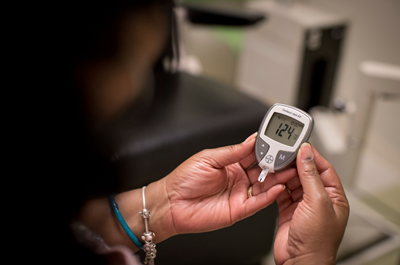In this podcast, we talk with Cara Orr, PA-C, assistant professor in the Physician Assistant (PA) Studies program, and Julie Quinlan, MPO, MS, CPO, ATC, FAAOP, instructor in the Orthotics and Prosthetics (O&P) program. They talk to us about the importance of interprofessional collaboration when it comes to treating diabetic patients.
Q: What is diabetes?
Orr: Diabetes is actually a very complex disease process. But, if we kind of boil it down, we have a problem of either a lack of insulin and/or a decreased sensitivity to the insulin that the body is producing. And this depends a little bit on the type of diabetes. For instance, in type 1, we have autoimmune destruction of the cells in the pancreas that make insulin, and so therefore they can't make the insulin and secrete it. In type 2 diabetes, we do see some impaired production of insulin, but it's still making some. Unfortunately, even the insulin that the pancreas is secreting, when it's secreted into the body, it can't be used properly in the peripheral tissues like it would be in a healthy person.
 Because the insulin isn't there to work properly, the sugar from our food ends up staying in our blood, which is a problem. The insulin can't move it into the cells where it's supposed to go so that it can be used. When it stays in our blood, this is called hyperglycemia. This leads to a number of different complications, but essentially it causes a lot of inflammation in our blood vessels, which means that the vessels can't work properly and we have decreased blood flow to tissues. The increased sugar levels also lead to a lot of damage to our nerves. In large part, it's the combination of this vascular damage and nerve damage that leads to the complications of diabetes, which is what a lot of patients really struggle with. This can damage the nerves, as I mentioned, so people have numbness and tingling. It can damage the retina in the back of the eye leading to vision problems or even blindness. It affects our kidneys. This can lead to weakened immunity and poor wound healing. And there's also hearing loss associated with diabetes. So the complications can really have a widespread effect.
Because the insulin isn't there to work properly, the sugar from our food ends up staying in our blood, which is a problem. The insulin can't move it into the cells where it's supposed to go so that it can be used. When it stays in our blood, this is called hyperglycemia. This leads to a number of different complications, but essentially it causes a lot of inflammation in our blood vessels, which means that the vessels can't work properly and we have decreased blood flow to tissues. The increased sugar levels also lead to a lot of damage to our nerves. In large part, it's the combination of this vascular damage and nerve damage that leads to the complications of diabetes, which is what a lot of patients really struggle with. This can damage the nerves, as I mentioned, so people have numbness and tingling. It can damage the retina in the back of the eye leading to vision problems or even blindness. It affects our kidneys. This can lead to weakened immunity and poor wound healing. And there's also hearing loss associated with diabetes. So the complications can really have a widespread effect.
Q: Julie, how do O&Ps treat a person with diabetes?
Quinlan: There are approximately 26 million individuals in the United States with diabetes. Of them, many experience neuropathy, loss of sensation, and also difficulty with vision as a result. These individuals are at a higher risk of wounds due to the effect it has on the circulatory system. And we see these patients to fit them with diabetic foot orthoses. This helps to prevent wounds from occurring. If a wound does occur, we see them to help offload that wound with orthotic treatments, most commonly foot orthotics and ankle/foot orthoses. But also, we work with these individuals that have experienced limb loss due to diabetes. Of the two million people that are living with limb loss, 60 percent of those amputations in the United States are a result of complications from diabetes. But we fit them with a prosthesis to help them regain their function and allow them to return to activities prior to the amputation.
Q: How do PAs treat a person with diabetes?
Orr: PAs work across all of the different medical specialties, so a patient with diabetes might encounter a PA in a variety of settings. However, when you just think about primary care and family medicine where I work, we play a large role in screening for diabetes and hopefully preventing the development of that. Certainly for patients that have risk factors and maybe elevated sugar levels, we're working to really educate them on what diabetes is and hopefully prevent the progression to diabetes. In those patients that already have it, we're also talking with them about lifestyle modifications. So how are they eating? What's their physical activity like? Are there things they can do to decrease inflammation in their systems? We're working with them to develop a unique treatment plan that addresses their disease process and their goals and needs. And then we would manage their medications and treatment over time.
 We want to be monitoring for any of the complications that Julie and I have mentioned already and hopefully preventing them from happening. And then of course, we're going to be coordinating their care with all of the different specialists that they're going to be seeing. For instance, if they have developed calluses or wounds, then certainly having an O&P on the interprofessional team is really important so that we can hopefully prevent further complications of that. They're going to be seeing an eye doctor every year, a podiatrist every year. They might need to see a kidney specialist or a cardiologist as well. Oftentimes, too, patients with diabetes have a lot of other health problems like hypertension, high cholesterol among others, and so we're also managing those comorbidities. It's also really important that we are looking at the patient as a whole person and addressing any mental health concerns that they might have because many of our patients with diabetes do struggle with anxiety and depression because of the significant impact the diabetes has on their lives.
We want to be monitoring for any of the complications that Julie and I have mentioned already and hopefully preventing them from happening. And then of course, we're going to be coordinating their care with all of the different specialists that they're going to be seeing. For instance, if they have developed calluses or wounds, then certainly having an O&P on the interprofessional team is really important so that we can hopefully prevent further complications of that. They're going to be seeing an eye doctor every year, a podiatrist every year. They might need to see a kidney specialist or a cardiologist as well. Oftentimes, too, patients with diabetes have a lot of other health problems like hypertension, high cholesterol among others, and so we're also managing those comorbidities. It's also really important that we are looking at the patient as a whole person and addressing any mental health concerns that they might have because many of our patients with diabetes do struggle with anxiety and depression because of the significant impact the diabetes has on their lives.
Q: How do your two professions, O&P and PAs, work together to treat a patient with diabetes?
Quinlan: It's important for us to remain in regular communication with each other so we can help to support the patient. For instance, if a patient's A1C is very high, we have the understanding that it's going to be difficult to possibly prevent wounds, and we may change the materials that we're using in their prosthesis or their orthosis to help to try to circumvent that or prevent that. We also need to be able to assess changes that we're seeing, for instance, if there's a wound or a potential infection, and be able to refer them for care as quickly as possible if that's needed. So I think the more eyes that are on the patient and that we're communicating very frequently, the better the outcome for the patient.
Q: Do either of you have a story that you could share about a time that you did collaborate with the other profession to treat a diabetic patient?
Quinlan: Recently, a PA that I was working with that works in wound care, had called me and said she had a patient that was in a total contact cast. And before she changed them to hopefully their final cast, she wanted me to come in to do an evaluation and take measurements and do a shape capture of the individual so that when their total contact cast was removed, they could go right into the ankle/foot orthosis that she was prescribing. This way it helps close that time gap that it would put the patient at a high risk to reopen that newly healed wound. In that case, it was very beneficial for the patient to have the coordination of the two of us to help the continuity of their care.
Q: Why do you think it's so important that professions collaborate when it comes to treating diabetic patients?
Orr: I think there's so many important things about really working together and collaborating, but I think one of the biggest things is compliance in patients. By working together, we can really encourage our patients to sort of stick with their treatment plan. If I'm talking to a patient about, "Hey, it's really important that you're seeing your podiatrist and that you're wearing the proper footwear so that we can prevent pressure points and calluses and potentially ulcers and wounds from forming." Then when they see Julie, if she's reiterating the same thing and like, "Hey, have you been in touch with your primary care provider? How are you doing with your diabetes control?" It shows that we're communicating and that we are a team that's available to help support the patient. I think that that really helps promote the patient feeling engaged and encourages them to stay on track. It also keeps them kind of in this continuous process of, like Julie mentioned earlier, constantly having eyes on them and making sure they're staying up to date with their care.
Q: Is there anything else either of you would like to add?
Orr: It's important that we really encourage everybody to take a step back, look at our own health, and to work toward a healthy lifestyle so that we can prevent diabetes. For any of us that know someone with diabetes, which is probably most of us, just encouraging them to stay up to date with their primary care provider and their other diabetes care specialists. I really think that awareness and education are the key, not only to avoiding diabetes altogether if possible, but for patients that have diabetes to maintaining a healthy quality of life that will allow them to live a long time